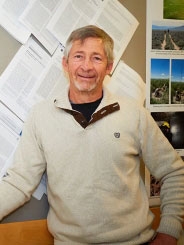Tom Manley
Professor Emeritus

Tom Manley received his doctorate from Lamont-Doherty Earth Observatory of Columbia University in physical oceanography of mesoscale dynamics in the Arctic Ocean and Greenland Sea. He began teaching at Middlebury College in the Fall of 1990. Tom teaches Oceanography, Coastal Processes and multi-dimensional visualization courses. His work is in the hydrodynamics of Lake Champlain and the Buffalo River. This work has management implications and is often used by municipalities in how best to preserve and keep Lake Champlain healthy.
Courses Taught
GEOL 0500
Readings And Research
Course Description
Readings and Research
Individual or group independent study, laboratory or field research projects, readings and discussion of timely topics in earth and environmental science. (Approval only)
Terms Taught
GEOL 0700
Senior Thesis Research
Course Description
Upon completion of GEOL 0400, all senior geology majors will continue their independent senior thesis research by taking one unit of GEOL 0700. This research will culminate in a written thesis which must be orally defended. (Approval only)
Terms Taught
Publications
- Manley, P.L., T.O. Manley, K. Hayo and T.M. Cronin, (2011) Small-scale Lacustrine Drifts in Lake Champlain, Vermont, Journal of Great Lakes Research. doi:10.1016/j.jglr.2011.05.004
- Manley, T.O., M. McCormick, J-C. Gascard, P. Tillier; K. L Hunkins, P. L. Manley (2011) An Initial View of Subsurface Lagrangian Observations in Lake Champlain; General Patterns, Cross-lake Flow and Coastal Currents. Journal of Great Lakes Research.
- Manley, T.O., (2010) Drifters, Drogues, and Circulation, Oceanography, December 2010, p. 165-171.
- Manley, P.L. and T.O. Manley, In a Slump, 2009, Professional Surveyors Magazine, vol. 29, p. 18-20
